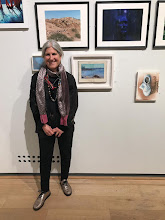 |
| Hyacinth Inclination, pastel on fabriano, 40 x 37 cm |
Below you can see what I saw when I began drawing on Sunday morning, late afternoon and today, when I think I have finished.
 |
| when I first set the still life up |
 |
| at the end of the first drawing day |
 |
| when I finished drawing today |
So when I came to the studio yesterday evening, after reading another slug of the book, quite dejected about the ten-or-so hours I'd already put into the drawing and how much of a failure it was, I was wondering about whether the world should be expressed as it is or in a perfected way. Do I need to bother with the colour of what I actually see or is the still life a stimulus for something I want to see. I know I used to think that way…The NEAC scholarship has pushed me towards being accurate in my observation and that means I hit this snag. What if the colour doesn't work?
That's what happened yesterday, the colour didn't work. I hated the colour in places. The composition was bitty and I was ready to give up. The book with its analysis of opposing viewpoints helped me find a way around the snag - I would simplify what I was drawing - not wipe it out as Peter suggests (that makes pastels muddy depressing)- erase and use the side of the pastel to reject what I see in order to see what else can work. As John and Mick and Peter would say 'it's not a copy'.
I found something similar to the colour so that I could find a different 'reality' I and draped it behind. The picture would become a postcard and I'd let the hyacinth collapse and the tulips splay. When I was done and it was dark (9pm) the left side and the right side weren't speaking to each other. This morning after reading another few pages of Gaiger I was thinking about the marks versus the objects and how to create excitement in the marks which add to but are distinct in themselves. That thought helped me to bring the sides together.
Bigger pastels of live things are troublesome but perhaps that working harder is a good thing? Sandy Larkman asked for something big and colourful for Brushstrokes, a charity that raises money through art exhibitions. Maybe I'll exhibit this one.


























